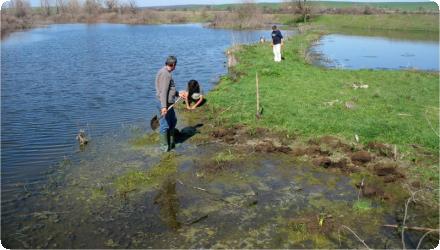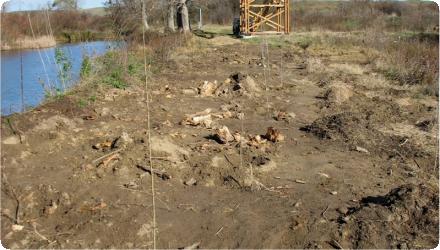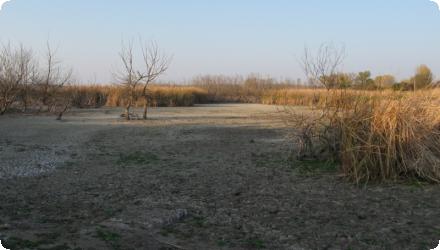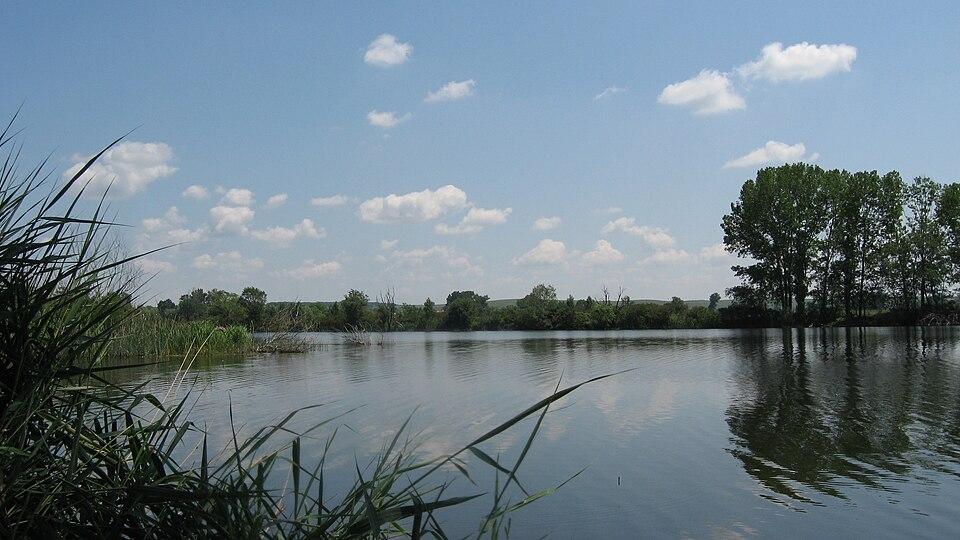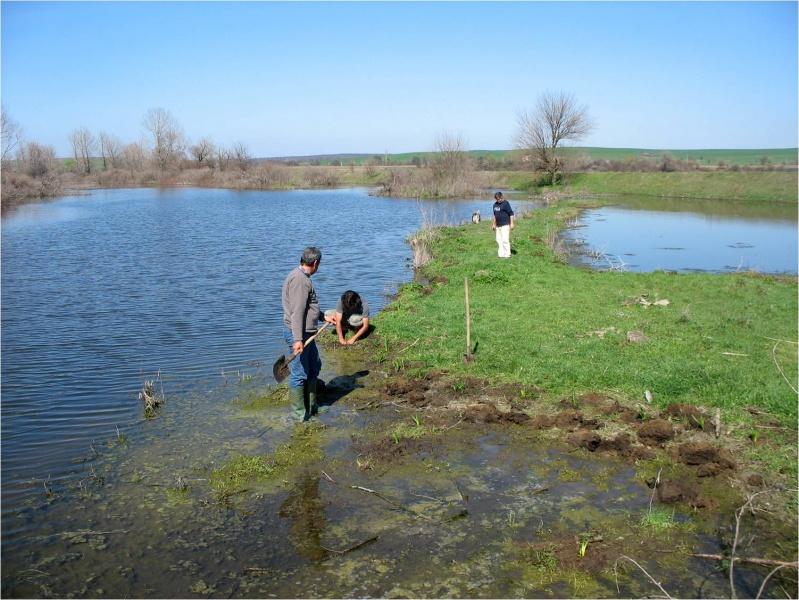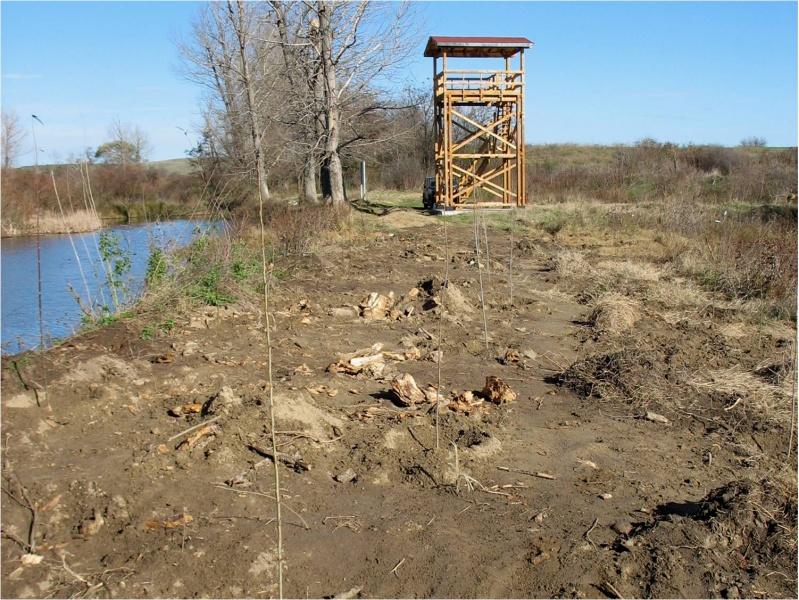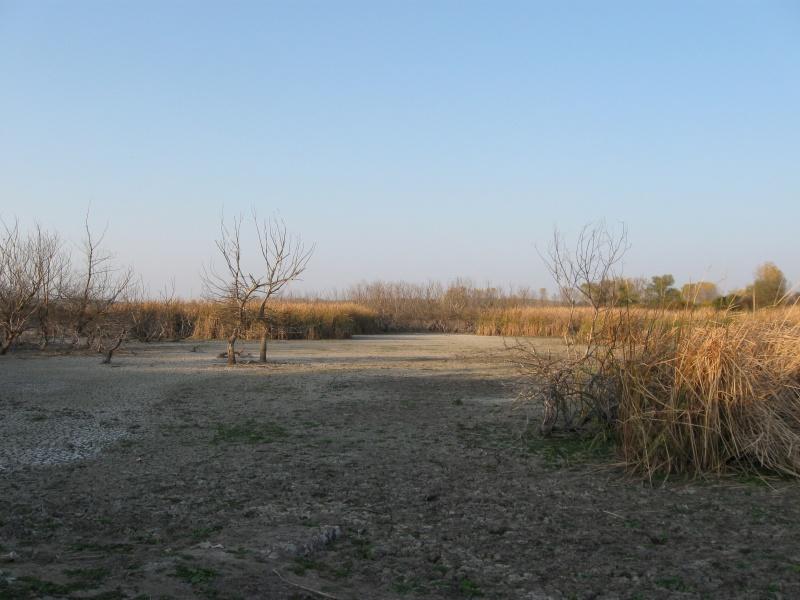Last update
2025
Summary
Dimitrovgrad Municipality restored, protected and promoted the sustainable development of the “Zlato pole” protected area by securing additional water to maintain its hydrological regime and constructing a hydraulic intake and supply channel. Water is diverted from the Martinka River, via a small intake and settling basin, then conveyed ~580 m in a buried 600-mm pipe and ~520 m in an open canal with control gates; the scheme was completed in 2013. The 84.79-ha site overlaps the Natura 2000 SPA BG0002103 “Zlato pole”, for which the Ministry adopted site-specific conservation objectives in June 2024, including targets for key birds such as Pygmy Cormorant and Ferruginous Duck and for wetland habitats. Management is overseen by RIEW Haskovo, with an information centre in Raynovo supporting education and visitors. Post-project actions have included nest boxes, aquatic plantings (white waterlily) and safeguarding of Leucojum aestivum. Current pressures reported on site are recurrent fires, illegal hunting/fishing and occasional flooding along the Martinka. Overall, the restoration sustains wetland hydrology, enhances habitat mosaics on the Maritsa floodplain and underpins ongoing Natura 2000 commitments, while requiring continued local engagement and enforcement.
Position
Latitude
42.03138
Longitude
25.7216
Project
NWRM
National Id
Bulgaria_04
Installation date
2012-07
Implementation Status
Contact
REC
RBD code
BG3000
Transboundary
0
Photo gallery
Location of the project
The protected area lies on the left bank of the Maritsa River, immediately south of Zlato pole village (Dimitrovgrad Municipality), and spans the lands of Zlato pole, Raynovo, Brod (plus Nova Nadezhda of Haskovo Municipality).
NUTS Code
BG42 - Южен централен (Yuzhen tsentralen)
Project's objectives
Restore the hydrological regime by diverting water from the Martinka River via a small intake and settling basin, then ~580 m of buried Ø600 mm conduit + ~520 m open canal (slope 0.0015), with 8 inspection shafts and an operations plan (incl. emergency/pollution response). Target construction time: ~120 working days.
Recover floodplain riparian forests typical of the site through afforestation on ~60 decares (~6 ha) with local willow and poplar species; establish a black poplar mother stock/nursery and control Amorpha (invasive).
Reintroduce and reinforce rare plants: Leucojum aestivum and Nymphaea alba (e.g., municipal news reported >20 water-lily rhizomes planted; Green Balkans reported 30 new water lilies).
Education, access and anti-disturbance measures: create an Information/Visitor Centre in Raynovo, build two birdwatching towers, three gazebos, 15 litter bins, update zoning/marking and install interpretive signage.
Recover floodplain riparian forests typical of the site through afforestation on ~60 decares (~6 ha) with local willow and poplar species; establish a black poplar mother stock/nursery and control Amorpha (invasive).
Reintroduce and reinforce rare plants: Leucojum aestivum and Nymphaea alba (e.g., municipal news reported >20 water-lily rhizomes planted; Green Balkans reported 30 new water lilies).
Education, access and anti-disturbance measures: create an Information/Visitor Centre in Raynovo, build two birdwatching towers, three gazebos, 15 litter bins, update zoning/marking and install interpretive signage.
Involved Partners
| Authority type | Authority name | Role | Comments |
|---|---|---|---|
Climate zone
warm temperate dry
Temperature
12,6
Precipitation
600
Annual rainfall range
600 - 900 mm
Runoff
1
Runoff range
600 - 750 mm
Elevation range
83 m
Slope range
0.0
Vegetation class
Shallow water bodies with extensive reedbeds and bulrush stands (i.e., emergent macrophyte marsh), with adjacent riparian willow vegetation, islands and pastures on the floodplain. This “reedbed/wetland emergent vegetation” is the dominant class.
Water bodies: Ecological Status
Poor
Water bodies: Chemical Status
Failing to achieve good
Water quality status
exceedances of good-status standards for total nitrogen, total phosphorus, nitrate-N, nitrite-N and orthophosphates
Project scale
Micro
Project scale specification
This project targets a single protected site—the Zlato Pole Protected Area—through localised hydromorphological works (a small intake, settling basin and ~1.1 km supply canal) to maintain wetland water levels. The intervention footprint is the protected area itself (84.79 ha) on the Maritsa floodplain near the villages of Zlato pole, Raynovo and Brod; it does not cover a whole sub-basin or region.
Performance timescale
1 - 4 years
Project area
84.79 ha
62
Need to sustain existing dykes for flood security
Protected area; Financing
Total cost
€313,315.95
Financing authorities
Type of funding
EU-funds: Cohesion and regional development funds
Comments
€266,318.56 or BGN 520,874
Type of funding
National funds
Comments
€46,997.39 or BGN 91,919
Compensations
0
Policy context
Interupted hydrawlic connection with main river and trained tributary; Habitat fragmentation
Land ownership
35% state, 12% municipal, 53% private
Community involvment
Yes
Design consultation activity
| Activity stage | Name | Key issues | Comments |
|---|
Policy target
| Target purpose |
|---|
|
Improved Biodiversity
|
|
Increase Water Storage
|
|
Oher Societal Benefits
|
Policy pressure
| Pressure directive | Relevant pressure |
|---|
Policy impact
| Impact directive | Relevant impact |
|---|
Requirement directive
| Requirement directive | Specification |
|---|
Contractual arrangements
0
| Arrangement type | Responsibility | Role | Name | Comments |
|---|
Part of wider plan
0
Wider plan type
| Wider plan type | Wider plan focus | Name | Comments |
|---|
Bird and site surveillance is carried out through project-foreseen guarding during the breeding season, routine inspections by RIEW Haskovo, and NGO bird monitoring; Natura 2000’s 2024 objectives also call for multi-year, systematic species monitoring.
number of breeding pairs, size of wintering population (individuals), area of suitable habitat (ha), and the ecological status/potential of water bodies used by target species (as per the River Basin Management Plan). Project texts also foresee presence/guarding records at the colony and amphibian breeding checks (with potential larval translocation if pools dry). Together, these indicate a monitoring set focused on population counts, habitat extent/condition, and water-body status relevant to the wetland.
Maintenance
The intake–canal system is operated with periodic care of sluice gates and sediment flushing, and the municipality has procured repairs to the canal (2013), indicating ongoing municipal maintenance via contractors.
Nature-based recreation & ecotourism : Visitor infrastructure includes birdwatching towers (2) and gazebos/shelters for visitors.
Raising public awareness of the conservation value of the site and involvement of citizens in the measures for its protection
Information on retained water
intake + settling basin + conveyance (buried pipe and open canal) built to feed the former Maritsa meander
Water quality overall improvements
Positive impact-WQ improvement
1
Heron colony size: Green Balkans reports about 140 nests (Grey Heron, Little Egret, Night Heron) within the protected area. Positive indication that suitable nesting habitat persists.
Pygmy Cormorant (winter roost): the site (Zlatopole/Raynovo) is a regular roost within the Maritsa valley network. A 23-year study (1996–2019) covering 7 roosts including Zlatopole & Raynovo found 3,065–8,180 wintering birds annually across the valley and an increasing trend overall; it does not isolate the Zlato pole project’s specific contribution.
Local maxima cited in management texts: older official material for the site mentions up to ~2,000 Pygmy Cormorants in winter (contextual importance; not a project effect evaluation).
Habitat features added: c. 100 nest boxes for cavity-nesters were installed at Zlato pole (conservation action; no quantified breeding response published).
Pygmy Cormorant (winter roost): the site (Zlatopole/Raynovo) is a regular roost within the Maritsa valley network. A 23-year study (1996–2019) covering 7 roosts including Zlatopole & Raynovo found 3,065–8,180 wintering birds annually across the valley and an increasing trend overall; it does not isolate the Zlato pole project’s specific contribution.
Local maxima cited in management texts: older official material for the site mentions up to ~2,000 Pygmy Cormorants in winter (contextual importance; not a project effect evaluation).
Habitat features added: c. 100 nest boxes for cavity-nesters were installed at Zlato pole (conservation action; no quantified breeding response published).
Key lessons
It is important to involve local authorities (municipalities) as main driving organizations in river restoration works, especially in cases where the main targeted lands are municipal property. The EU funds (ERDF) provide good opportunities for implementation however the practical experience is still limited.
Municipal leadership was decisive. Dimitrovgrad Municipality was the project beneficiary and operator, coordinating design, tendering, construction and subsequent operation—exactly the governance model that enabled a small, site-level intervention to happen.
Technical simplicity plus clear O&M matters. A modest intake on the Martinka River, a settling basin, and ~1.1 km of conveyance were paired with an operations plan (gate management, sediment flushing; normal vs. emergency modes). This pairing is a transferable lesson for similar floodplain wetlands.
Build partnerships for stewardship. The project design includes seasonal guarding of the heron colony and fishing restrictions, while NGO actors contribute monitoring and outreach—showing how agency–municipality–NGO roles can be complementary.
Invest in public engagement infrastructure. The Information/Visitor Centre in Raynovo and attendant amenities created a focal point for education, ecotourism and community programming, which helps sustain local support beyond the construction phase.
Plan for risks and enforcement. Post-project fires inside the protected site and recurring poaching pressures underline the need for prevention, surveillance and rapid response baked into management.
Align restoration with current Natura 2000 objectives. In 2024, Bulgaria adopted site-specific conservation objectives for SPA BG0002103 Zlato pole; tying management to these measurable targets strengthens accountability and provides a framework for long-term monitoring.
Close the evidence gap on outcomes. Publicly available documents emphasise actions and species aims, but provide little quantified before/after evidence for hydrology or water quality at Zlato pole; meanwhile, nearby Zlatopolska River monitoring registers nutrient exceedances—arguing for future projects to budget dedicated, site-level monitoring from the outset.
Municipal leadership was decisive. Dimitrovgrad Municipality was the project beneficiary and operator, coordinating design, tendering, construction and subsequent operation—exactly the governance model that enabled a small, site-level intervention to happen.
Technical simplicity plus clear O&M matters. A modest intake on the Martinka River, a settling basin, and ~1.1 km of conveyance were paired with an operations plan (gate management, sediment flushing; normal vs. emergency modes). This pairing is a transferable lesson for similar floodplain wetlands.
Build partnerships for stewardship. The project design includes seasonal guarding of the heron colony and fishing restrictions, while NGO actors contribute monitoring and outreach—showing how agency–municipality–NGO roles can be complementary.
Invest in public engagement infrastructure. The Information/Visitor Centre in Raynovo and attendant amenities created a focal point for education, ecotourism and community programming, which helps sustain local support beyond the construction phase.
Plan for risks and enforcement. Post-project fires inside the protected site and recurring poaching pressures underline the need for prevention, surveillance and rapid response baked into management.
Align restoration with current Natura 2000 objectives. In 2024, Bulgaria adopted site-specific conservation objectives for SPA BG0002103 Zlato pole; tying management to these measurable targets strengthens accountability and provides a framework for long-term monitoring.
Close the evidence gap on outcomes. Publicly available documents emphasise actions and species aims, but provide little quantified before/after evidence for hydrology or water quality at Zlato pole; meanwhile, nearby Zlatopolska River monitoring registers nutrient exceedances—arguing for future projects to budget dedicated, site-level monitoring from the outset.
Success factor(s)
| Success factor type | Success factor role | Comments | Order |
|---|---|---|---|
|
Attitude of decision makers
|
main factor
|
<p>Good cooperation between local authorities and NGO</p>
|
1
|
|
Existing staff and consultant knowledge
|
main factor
|
2
|
|
|
Financing possibilities
|
secondary factor
|
3
|
|
|
Available support tools
|
secondary factor
|
4
|
Driver
| Driver type | Driver role | Comments | Order |
|---|---|---|---|
|
Organisation committed to it
|
main driver
|
Commitment of Dimitrovgrad municipality and support by Green Balkans NGO
|
1
|
Transferability
Highly transferable to small floodplain wetlands needing hydrologic top-ups via simple intake+canal. Success hinges on municipal leadership, clear O&M (gate ops, sediment flushing), correct hydrologic sourcing, and alignment with conservation objectives. Check land ownership, permits, sediment/nutrient loads, and plan for enforcement and fire risk; fund monitoring to evidence outcomes.
English

